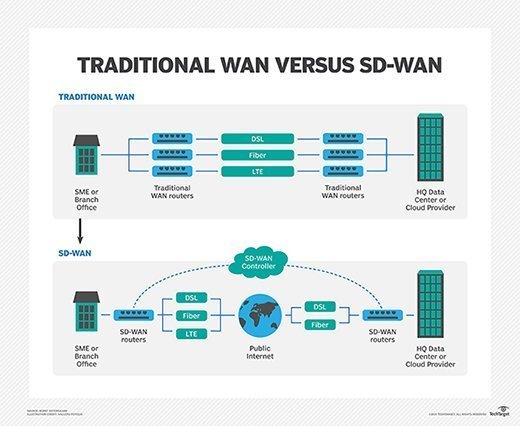
kentoh - Fotolia
A glossary for the terms and types of WAN technologies
This introduction to WAN technologies defines several different terms -- such as VPN and SD-WAN -- that are essential in anybody's networking vocabulary.
In the beginning, there were LANs. Well, it wasn't the very beginning, but the creation of LANs eventually led to other networking advancements, such as wide area networks and different types of WAN technologies.
LANs, or local area networks, connect computers and devices in the same geographic area. As technology grew and advanced, so did the need for a network to stretch out and support an increasing number of devices. Technological advancements led to greater variety in types of WAN technologies and architectures to benefit any enterprise network.
This glossary covers both old and new types of WAN technologies, concepts and protocols that are essential for any network team. Review these nine key terms, and establish a general knowledge of why they're important.
Introduction to types of WAN technologies
WAN. A WAN, or wide area network, is a private network that connects multiple geographically distributed locations and LANs. An organization's WAN connects its headquarters with branch offices and other facilities so those distributed sites can access business resources and applications. A WAN can use wired or wireless connections, as well as privately owned links or those obtained from a service provider. Wired WANs remain the most popular among enterprises.
ROBO. ROBO stands for remote office/branch office, which is a business site distant from enterprise headquarters. ROBOs can operate like the main office or provide a different, specialized service. ROBOs can be as close as a few miles from headquarters or as far as another country. IT teams are usually based in main offices, so they solve issues and ensure data is properly stored for ROBOs from a distance, which can cause issues for either side.
VPN. A virtual private network is software that uses encrypted tunnels to connect authorized remote employees to an organization's network and business resources. Traditionally, VPN client software runs on individual user devices, commonly using remote access and site-to-site configurations. Branch office employees originally used VPNs to access enterprise applications in a safe, cost-efficient way. Now, VPNs are also useful for remote employees, mobile workers, BYOD and more.
MPLS. MPLS stands for Multiprotocol Label Switching, a routing technique designed to shape and quicken the pace of traffic flows throughout the network. MPLS forwards data packets at Layer 2 rather than Layer 3 using labels that contain information about a packet's predetermined path and priority level to move traffic. Despite its higher cost, MPLS has retained its place among enterprises due to its high performance, quality of service and reliability. Further, MPLS functions regardless of protocol or transport type, such as IP or Ethernet.

BGP. The Border Gateway Protocol is a routing protocol that directs packets across the internet. BGP typically routes information for an autonomous system -- such as an internet service provider network -- and relays the traffic's network prefixes and information to the WAN. Edge routers use BGP and routing tables to determine the shortest path and make decisions based on network administrator policies and path attributes.
SLA. A service-level agreement is a contract between a service provider and customer that helps manage the alignment of customer expectations and the provider's services. SLAs are important for WAN services and connectivity to ensure high performance and reliability for network applications. An SLA should include a statement of objectives, a list of the provider's services, the responsibilities of both the provider and the customer, performance metrics and penalties if the provider doesn't meet the established expectations.
QoS. QoS, or quality of service, manages and measures data traffic and network resources to ensure the network performs as needed. Network administrators can set data type priorities, and QoS helps organizations meet traffic requirements of sensitive applications -- for example, real-time video and audio. QoS measures metrics like packet loss, latency, jitter, bandwidth and mean opinion score -- a voice quality metric.
SD-WAN. A software-defined WAN is an emerging type of WAN technology. It uses concepts from software-defined networking for routing traffic across a network. SD-WAN creates and acts as a virtual overlay across existing WAN links and connections to optimize bandwidth and transport data. Organizations can use SD-WANs to prioritize business-critical traffic and to configure failover policies. SD-WANs are managed by centralized controllers and aim to simplify network operations, such as security and reliability.
WAN optimization. The goal of WAN optimization is to increase the speed of a user's access to critical applications and information on a network. Also known as WAN acceleration, the technologies in this category ensure data flows efficiently across a WAN. It encompasses several different practices, including traffic shaping, data caching, protocol spoofing and more.








